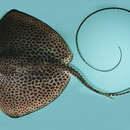Diagnostic Description
(
englanti
)
tarjonnut Fishbase
Huge stingray with conspicuous dark spots on a light brown disc; spots well-spaced in young but crowded to form reticulated pattern in adult; white ventrally; tail marked with bands of black and white; snout sharply pointed; disc with narrowly rounded outer corners, and tail long, slender and nearly three times body length when intact, with no caudal finfolds; disc without thorns but with band of flat denticles along midback (in adults); usually 1 medium-sized sting on tail (Ref. 5578).
- lisenssi
- cc-by-nc
- tekijänoikeus
- FishBase
- Recorder
- Cristina V. Garilao
Life Cycle
(
englanti
)
tarjonnut Fishbase
Exhibit ovoviparity (aplacental viviparity), with embryos feeding initially on yolk, then receiving additional nourishment from the mother by indirect absorption of uterine fluid enriched with mucus, fat or protein through specialised structures (Ref. 50449). Distinct pairing with embrace (Ref. 205). Distinct pairing with embrace (Ref. 205). Bears 3 to 5 young in the summer (Ref. 5578). Size at birth about 21 (Ref.58048) - 28 cm WD (Ref. 6871).
- lisenssi
- cc-by-nc
- tekijänoikeus
- FishBase
- Recorder
- Cristina V. Garilao
Migration
(
englanti
)
tarjonnut Fishbase
Amphidromous. Refers to fishes that regularly migrate between freshwater and the sea (in both directions), but not for the purpose of breeding, as in anadromous and catadromous species. Sub-division of diadromous. Migrations should be cyclical and predictable and cover more than 100 km.Characteristic elements in amphidromy are: reproduction in fresh water, passage to sea by newly hatched larvae, a period of feeding and growing at sea usually a few months long, return to fresh water of well-grown juveniles, a further period of feeding and growing in fresh water, followed by reproduction there (Ref. 82692).
- lisenssi
- cc-by-nc
- tekijänoikeus
- FishBase
- Recorder
- Crispina B. Binohlan
Morphology
(
englanti
)
tarjonnut Fishbase
Dorsal spines (total): 0; Dorsal soft rays (total): 0; Analspines: 0; Analsoft rays: 0
- lisenssi
- cc-by-nc
- tekijänoikeus
- FishBase
- Recorder
- Cristina V. Garilao
Trophic Strategy
(
englanti
)
tarjonnut Fishbase
Euryhaline species. Found in sandy or muddy substrates (Ref. 127989). Common off sandy beaches and in shallow estuaries and lagoons; also found in sandy areas of coral reefs (Ref. 9710). Found on the continental shelf (Ref. 75154). Also offshore down to 50 m depth (Ref. 5578). May enter fresh water (Ref. 5578). Feeds on small fishes, bivalves, crabs, shrimps and worms.
- lisenssi
- cc-by-nc
- tekijänoikeus
- FishBase
- Recorder
- Drina Sta. Iglesia
Biology
(
englanti
)
tarjonnut Fishbase
Common off sandy beaches and in shallow estuaries and lagoons; also found in sandy areas of coral reefs (Ref. 9710). Also offshore down to 50 m depth (Ref. 5578). May enter fresh water (Ref. 5578). Feeds on small fishes, bivalves, crabs, shrimps, worms (Ref. 3263) and jellyfishes (Ref. 37816). Ovoviviparous (Ref. 50449). Common catch of the demersal tangle net, bottom trawl, longline and beach seine fisheries (Ref.58048). Popular angling fish (Ref. 3263). Not esteemed as a food fish (Ref. 3263). Used in Chinese medicine (Ref. 12166). Tail is used as It is parasitised by the monogeneans Dendromonocotyle colorni and Dendromonocotyle ukuthena on the dorsal skin surface (Ref. 124058).
- lisenssi
- cc-by-nc
- tekijänoikeus
- FishBase
- Recorder
- Crispina B. Binohlan
Importance
(
englanti
)
tarjonnut Fishbase
fisheries: commercial; gamefish: yes; aquarium: commercial
- lisenssi
- cc-by-nc
- tekijänoikeus
- FishBase
- Recorder
- Crispina B. Binohlan

